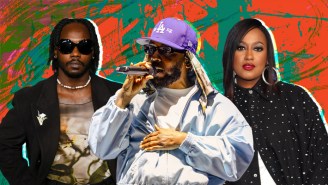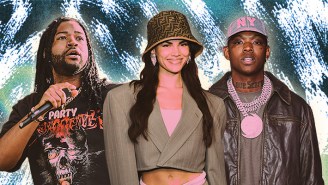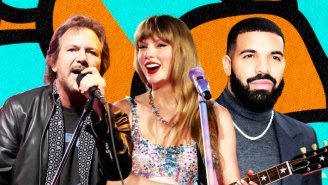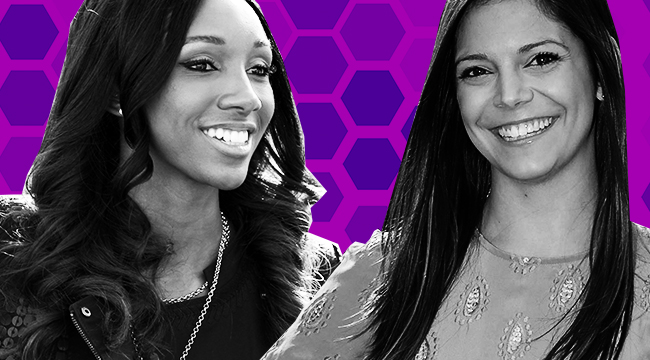
The ripples of female voices on the fringe in sports broadcasting a decade ago built into a wave crashing onto every major network. Fox Sports amplified Kristine Leahy’s voice after she toiled at the update desk for Colin Cowherd’s radio show. Digital star Rachel Bonnetta hosts a gambling show for FS1 called Locked It In. Even legacy media organizations not known for their progressive approach to coverage like Sports Illustrated have gotten into the act by hiring talented voices like Charlotte Wilder. This new class of compelling female personalities are now driving conversations and becoming the smartest voices in a specific section of the sports media market that had so often been reserved for loud men.
The rejoinder to arguments against women’s sports has always been an economic one — let the free market decide. As media companies scramble to squeeze every last drop of value out of their content creators, people who can do multiple things well become desired commodities. Drawing from a pool of men only would leave these networks with what we’ve long come to expect from them: A long line of relatively homogeneous — and outright boring — dudes.
“If all of a sudden you’ve got the cream of the crop women and you’re giving them a platform to say smart things, they’re going to say smarter things than your B guys,” explains Kate Fagan, who has become one of the top personalities on ESPN. “We’ve seen before the sports media world you’ve got your varsity and your JV guy lineup. Well, now you’ve got two varsity lineups, and now you’re seeing ESPN saying ‘Holy sh*t look what happens when we put Mina Kimes on.’ She’s an A+ talent with smart things to say, rather than having another guy with an A- take.”
Audience preferences are slowly evolving as the media landscape undergoes its own transformation. For years, the most prominent women in sports media were either sideline reporters or hosts, tossing to men for their opinion. The tide has started to turn, and it’s this group of ultra-talented, social media savvy women who have kicked down the door, driven by a yearning for something genuine and unique.
“It used to be, ‘I want to be a woman in sports, I have to be a sideline reporter,’” says ESPN’s Katie Nolan. “Now it’s ‘I want to be a sideline reporter because it’s a thing I want to do,’ not because I’m a woman and I want to work in sports. You can choose to be a reporter. You can choose to be a host. You shouldn’t be limited based on your boobs.”
The torchbearers for women offering their opinion in the sports world were names everyone recognizes: Jemele Hill, Michelle Beadle, Rachel Nichols, etc. In modern media culture, representation now looms large in every discussion, but that hasn’t always been the case.
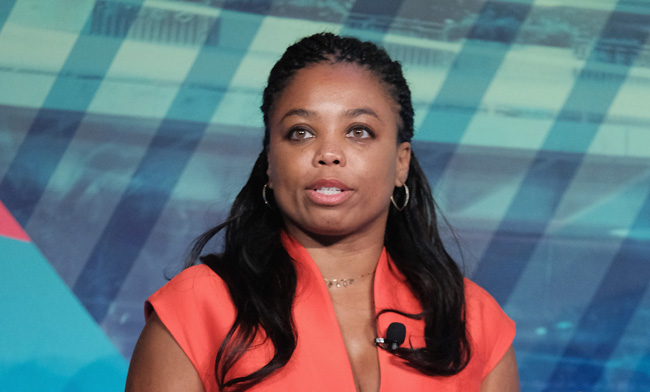
“Growing up, I didn’t watch ESPN that much because everyone on it was for men except SportsCenter,” Nolan says. “I would watch SportsCenter because that was just news… all the other shows were, ‘This was how I feel about this stuff from my perspective,’ but it was just dudes.”
With so few examples, it’s not surprising women felt excluded from roles in sports because it didn’t even seem plausible. That feeling of exclusion still applies to many today, especially women of color who account for fewer than eight percent of print newsroom staffs in the U.S. across coverage sections.
“Michelle Beadle made a joke that my boyfriend didn’t get and I got,” Nolan recalls. “It was a female-based joke. And I was like ‘holy sh*t what is this?’ And he said ‘SportsNation.’ I’m like ‘Who’s she?’ and he goes ‘That’s Michelle Beadle, she’s so hot’. And I was like ‘Yeah she is,’ — we broke up — but she just made a joke for me on sports TV, and I don’t think she was doing it on purpose. I don’t think she was like ‘I’m gonna make jokes for women.’ You just make jokes based on your experience, and she did. I was blown away by that, so when the possibility of working in sports TV came up, I thought well, I can do that.”
Many of the women who have become public commentators in this space also feel discouraged and frustrated with the burden they’ve had to bear when it comes to discussing issues revolving around violence against women.
Maria Taylor, a Swiss Army Knife for ESPN’s coverage of college football, points to a certain level of cowardice when turning to women to tackle these issues. It’s a sort of cover.
“Why do you only want to call me when a woman gets beaten?” Taylor asks. “You’re afraid to tackle that issue, but we’re expected to tackle that issue and give you the women’s perspective and how it relates to the NFL and how it relates to the player’s perspective. We have to operate in these very difficult subject matters that no one else is responsible for.”
For Fagan, weighing in on Ray Rice was both her entryway into the opinionist chair and a yoke she simply refused to wear at a certain point.
“It’s not fair to us we only get called when there’s a domestic violence situation, or some sort of gender, sexism, for me it was homophobia or an LGBT topic was the only time I was getting called,” Fagan says. “Before I even said anything, no one thought of me as a former professional basketball player, they didn’t think of me as having covered the Sixers, or knowledge about sports in any way… I didn’t think that was fair to us as women. The only time we were called because we’re going to start to condition the audience that it was the only opinions we were offering.”
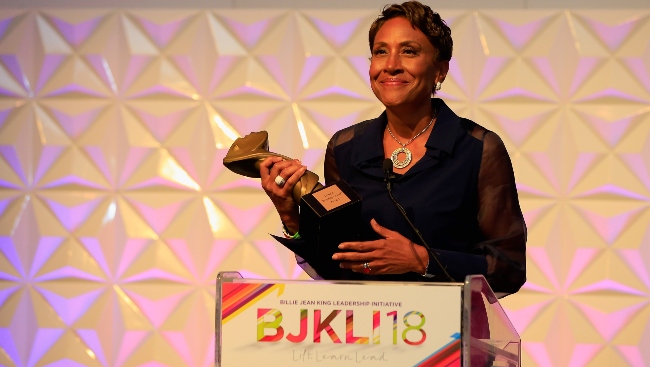
Just because there are more women on our televisions now doesn’t mean that the problem is fixed. Indeed, it extends well beyond the realm of sports and into every facet of our culture and everyday life. The question of “What’s it like to be a woman in sports?” comes with a certain level of disingenuousness simply because being a woman in the world carries its own challenges based on societal norms that exist outside of sports.
Kavitha Davidson, a former ESPN and Bloomberg writer, illustrates this example perfectly with a simple anecdote.
“I constantly joke, but it’s not actually a joke, that I’ve often been helped in my writing and people’s reactions to my writing by the fact not everyone knows what gender the name ‘Kavitha’ is and also not necessarily knowing the ethnicity,” Davidson says. “And having a last name like Davidson, my byline can be seen as fairly ambiguous as to whether or not a reader would understand I’m a woman of color. Now, on the other hand, that’s completely dehumanizing.”
Taylor points to Robin Roberts as the lone woman of color in sports with a universal approval rating. She understands the role she has to play in setting up future generations of young women, in particular, young women of color, but also understands that’s an issue unique to women.
“I don’t think any other man bears that,” Taylor says. “I don’t believe any man will care. They’ll pick up this article, read it, and be like, ‘This has nothing to do with me and there’s nothing I can do to help it.’”
The problem, of course, is that’s exactly who can help it. Cultural change, the acceptance from men of women in the sports space, is the lynchpin piece holding women back from being equals in sports media. And it’s still often a requirement of women to rely on the platforms of men.
Kimes credits her ESPN colleague Bill Barnwell for putting her on his podcast, what she calls a “hardcore football podcast.” Even before that, Danny Kelly liked Kimes’ Twitter personality enough to have her on his podcast for Field Gulls, the SB Nation Seahawks blog. The normalization of female voices by their male peers serves as a guiding light for sports fans who may otherwise never seek out such voices. Still, such amplification only goes so far.
“I think male commentators are allowed to drive the conversations that are important to them,” Fagan says. “That’s not something that I think as women we’re totally allowed to do yet. If I want to be relevant, I 100 percent have to follow what decades and decades of male producers have determined as important in sports media.”
A difference in the success stories of this new era of female sports commentators is the access to social media. It was something that past groups of women working in this field and trying to break through didn’t have, and it allows them to bypass traditional media outlets to find a niche. As everyone — from hosts, reporters, and beat writers — people who hadn’t traditionally been asked to opine took to social media to offer their takes, and these insightful women fired off takes of their own.
Their wit, intelligence, and often cutting sarcasm for male trolls ingratiates them to audiences, who in turn want to hang out with these women who were entertaining online during live sports. When they’re showing up on TV, that just seems like another hangout.
“You’re going to give your takes,” Nolan explains. “You’re going to get sh*t for them, but if you just keep doing it, you’re making it easier for yourself to do it and the next person to do it and for it to be done. You’re not going to see people not give you sh*t anymore in your mentions, but over time the sh*t becomes less sexist because you’ve been doing it for so long and they’re learning that telling you that ‘because you’re a woman you can’t give your takes’ isn’t working.”
Nolan suggests Dan Le Batard’s acceptance and support of Kimes, for example, helped catapult her forward. It’s a simple equation: His fans like his show, and he likes Kimes, so why shouldn’t his fans like her, too? If half of life is just showing up, then more than half of getting people to like watching someone on TV is just being on TV. Their mere presence in our collective consciousness serves to normalize that existence.
Rachel Bonnetta grew up in Canada watching Jay Onrait and Dan O’Toole, and never got to see women in sports media with the sort of quirky, dry comedic delivery she brings to her hosting and reporting.
“I think more and more women are doing this,” Bonnetta says. “They get this role, whether it be sideline or host or whatever, and they’re getting more and more confident being themselves because we have the Jemele Hill’s and Katie Nolan’s and Michelle Beadle’s to be themselves. I think over the next couple of years we’re going to find more and more women coming forward.”
And that representation, such as it already exists, didn’t take long to pay off.
“There was never really any time — not only do I not see myself reporting news, or reporting in front of the camera, I didn’t really see myself doing sports because I didn’t see anyone out there doing what I wanted to do,” Bonnetta says. “Whereas nowadays, I feel like if I were 10 years old watching Katie (Nolan) do her thing, I would say, ‘This is something I can see myself doing.’”
Bonnetta laments still seeing comments about her looks online, something many women on the internet face, irrespective of some high-profile public-facing job. That sort of internalized feeling of being out of place was a common thread among women interviewed for this story. For example, Fagan distanced herself from Around The Horn, a show that helped put her on the map to a certain degree for a reason would likely never occur to most men in sports.
“I don’t know why it is, but I don’t want to opine on sports that I’m not an expert on,” Fagan says. “I don’t look around and see a lot of male colleagues struggling with that conundrum. I’ve purposely removed myself from Around The Horn because I was having a lot of anxiety about certain sports I didn’t follow that closely and how much I would struggle when I had to talk about them. Maybe that’s some of my own internal issues, but I do wonder if on some level over the years I just always want to… and maybe women feel this way, they don’t want to do anything at a B+ level. They feel like they have to do it at an A level.”
Taylor tells the story of a trip to Utah to cover a BYU game. She says she’s constantly having to remind herself she belongs in meetings with coaches and players. It was her former colleague Matt Millen who took the time to let her know he saw her.
“He said, ‘You have to be the strongest person I know because you’re this black girl who flew from Atlanta to Provo to be around a bunch of white men. You don’t know anything that’s going on here… This has to be scary for you and this has to be hard for you. And I just want you to know that I recognize it and I see that you’re strong,’” Taylor recalls. “Sometimes that’s all we want, is someone to just recognize that there is a struggle, that the struggle’s not invisible, that I don’t have to get over it just because I’m in the space, and recognize I still have to deal with it every single day. Just because I’m here doesn’t mean it changes. One person doesn’t make it better. It’s going to take a collective to make it better for me and the next person coming up.”
Still, simply elevating more women and acknowledging that they face challenges that their male counterparts do not isn’t enough. How do we change that? Where do we go from here?
When asked, Nolan half-joked, “Oh, so I have to fix it too?”
“We can have trash takes,” Nolan says slightly more seriously. “I’ve long said you’ll know women have ‘made it’ in sports media when a woman who is absolutely awful and has the most awful takes is very prominent.”

“At what point do we realize women are operating in the same spaces as men and have writing skills?” Taylor asks. “Holly Rowe and I are on the road every single week covering the sport and no one has ever thought to come to us and say, ‘Hey you deserve a digital platform,’ or ‘you guys deserve to have a television show,’ or ‘You guys deserve to be the thought leaders on college football.’”
The key for moving forward further is all about trust, both building it with audiences and getting it from executives and producers on these shows.
“She’s been covering it for 22 seasons, but you don’t see people reaching out to Holly Rowe every time a story happens in college football,” Taylor continues. “You find Kirk Herbstreit commenting on it. They go straight to Rece Davis… part of that is ingrained in us that that’s who SportsCenter called. That’s who they called on, but they’re not thinking about the women who operate in the same space, who are in the same coaches meeting, who talk to these players every single week… because they’re women.”
The industry side isn’t something often discussed, but the cultural norms and gender dynamics extend beyond how audiences react to the boardrooms and production meetings where decisions about who is seen and heard are made. The goal should be to celebrate their accomplishments as innovative women, but also ultimately judge them on the quality of the work they do.
“I would like to be both praised and criticized for the content of what I say and the way I say it, not who I am as a person,” Kimes says. “A very small percentage of the stories we talk about actually invoke gender. There are stories about domestic violence — like when Ray Rice happened or now with Urban Meyer. There is a desire, a smart instinct, and a worthwhile urge at our company to say it’s good to have women talking about these stories. But that’s a very small portion of the stories we talk about, the topics we debate and the stories we write.”
Just doing it, continuing to make the thing in the face of all these obstacles is its own form of winning, showing other women it can be done. As the direct lines to journalism jobs blur, companies should continue to look for unique voices to create content. It used to be go to school, graduate with an internship, work the internship until a small market job opens and work up from there. That old foundation catered to middle- and upper-class white men. So, too, does the remaining infrastructure, but with so many more outlets, so many more mediums, and so fewer barriers to entry, those power dynamics have shifted.
Though we’re nowhere near a true meritocracy in sports media (or almost anywhere else), we’re closer than we’ve ever been.
As Sports Illustrated’s Wilder puts it, it’s only a start to “Be talented, show the f*ck up 130,000 percent, and just work your ass off.”
Perhaps one day it truly will be as simple as that meritocracy, but that day has not yet come. Just because it’s not here for Nolan or Kimes, Bonnetta or Taylor shouldn’t take away from the fact that a generation of previously marginalized people are watching those who look and sound like them on TV and on the internet. That’s progress for sports media. The content we’re getting is more diverse, more creative, and more dynamic than it’s ever been precisely because they’re in the space.
“For me, as a female viewer, there’s something welcoming about looking up, seeing First Take, seeing a woman debating and that’s just it —the content is the same, the structure is the same, the questions are the same, but there’s a woman there,” Kimes says, “When you look up and see someone like you, you not only think hey I could do that, if that’s your ambition, but you feel welcome in that space.”
“The fact that we’re there,” Kimes adds, “in a way, is revolutionary.”

